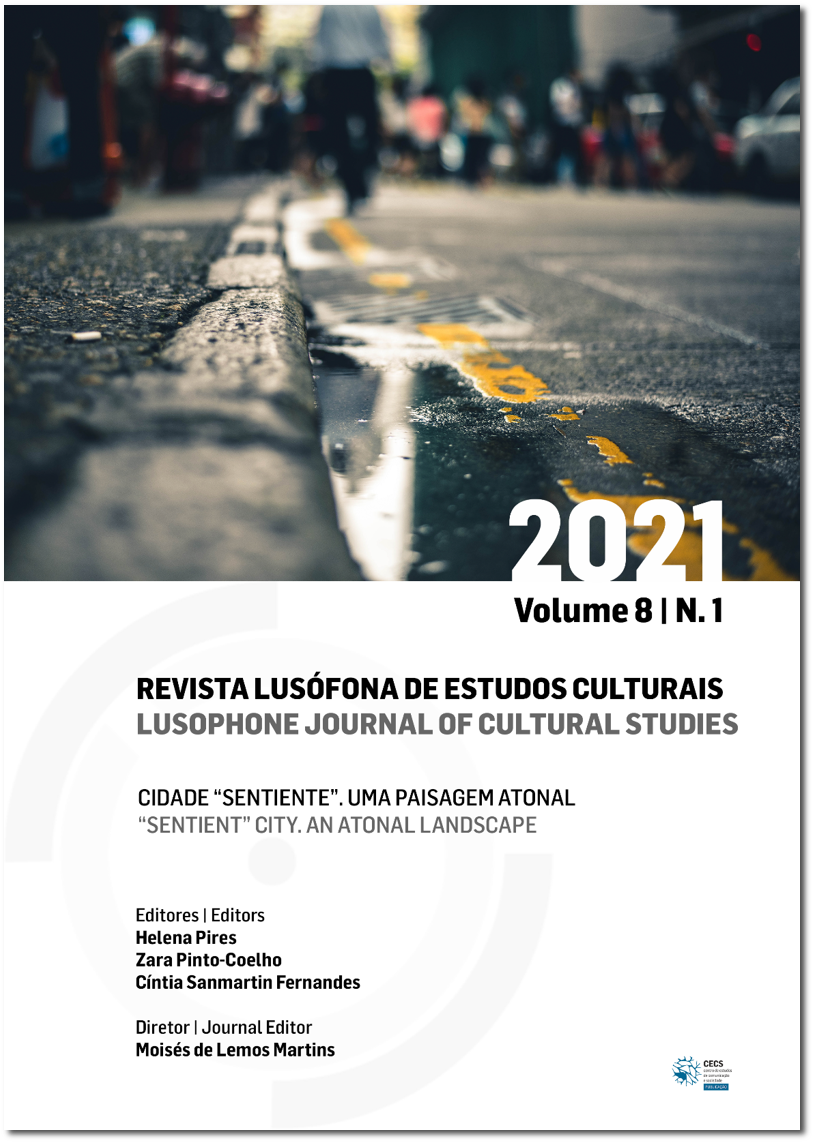On Walking While Confined
DOI:
https://doi.org/10.21814/rlec.3216Keywords:
choreopolice, choreopolitics, confinement, walkingAbstract
In the apparent paradox that the idea of “walking in confinement” contains — also in its relationship with the city — we have found, in the confinement experience, some possibilities of operating in this paradoxical tension. These will be hypotheses of choreopolitical potency, if put in opposition to the sensation of self-chorepolicing (the self-monitoring of one’s own movement) — and to the extreme attention given to the movement of the “other” as a danger - which can be transformed into propositions for social play.
Downloads
References
Antunes, R. F., Cláudio, A. P., Carmo, M. B., & Correia, L. (2017). Animating with a self-organizing population the reconstruction of medieval Mértola. In T. Schreck, T. Weyrich, R. Sablatnig, & B. Stular (Eds.), Eurographics workshop on graphics and cultural heritage (pp. 1–10). The Eurographics Association. https:// doi.org/10.2312/gch.20171286
Baudelaire, C. (2006). O pintor da vida moderna (T. Cruz, Trad.). Nova Vega. (Trabalho original publicado em 1863)
Benjamin, W. (2019). As passagens de Paris (J. Barrento, Trad.). Assírio e Alvim. (Trabalho original publicado em 1999)
Berardi, F. (2020). Crónicas da psicodeflacção (N. Leão, Trad.). Tigre de Papel. (Trabalho original publicado em 2020)
Bhalla, M., & Proffitt, D. R. (1999). Visual-motor recalibration in geographical slant perception. Journal of Experimental Psychology, 25(4), 1076–1096.
Breton, A. (1924). Manifesto surrealista. https://www.marxists.org/portugues/breton/1924/mes/surrealista.htm
Breton, A. (1972). Nadja. (E. Sampaio, Trad.) Editorial Estampa. (Trabalho original publicado em 1928)
Cachopo, J. P. (2020). A torção dos sentidos, pandemia e remediação digital. Sistema Solar.
Careri, F. (2013). Walkscapes, o caminhar como prática estética (F. Bonaldo, Trad.). Editorial Gustavo Gili. (Trabalho original publicado em 2002)
Carvalho, L. (2020, 31 de dezembro). How does one shoot a frozen clock? Ill Will Editions, Partisan Analysis of the Present. https://illwill.com/how-does-one-shoot-a-frozen-clock
Certeau, M. (2000). A invenção do cotidiano (E. F. Alves, Trad.). Editora Vozes. (Trabalho original publicado em 1990)
Coelho, S. P. (2018). Práticas de atenção: Ensaios de desterritorialização e performance coreográfica. Cadernos de Arte e Antropologia, 7(2),43–55. https://doi.org/10.4000/cadernosaa.1595
Debord, G. (1958). Théorie de la dérive. Internationale Situationniste, (2), 19–23. https://www.larevuedesressources.org/IMG/pdf/internationale_situationniste_2.pdf
Deleuze, G., & Guattari, F. (2004). Mil planaltos, capitalismo e esquizofrenia 2 (R. Godinho, Trad.). Assírio e Alvim. (Trabalho original publicado em 1972)
Di Marco, S., Tosoni, A., Altomare, E. C., Ferretti, G., Perrucci, M., & Committeri, G. (2019). Walking-related locomotion is facilitated by the perception of distant targets in the extrapersonal space. Scientific Reports, 9, artigo 9884. https://doi.org/10.1038/s41598-019-46384-5
Gibson, J. J. (1986). The ecological approach to visual perception. Lawrence Erlbaum Associates. (Trabalho original publicado em 1979)
Harms, I. M., van Dijken, J. H., Brookhuis, K. A., & de Waard, D. (2019). Walking without awareness. Frontiers in Psychology, 10, artigo 1846. https://doi.org/10.3389/fpsyg.2019.01846
Jara, A., Paim, F., & Lundin, J. (Hosts). (2020, 11 de dezembro). Journey #3 - Caos e ordem [Episódio de podcast áudio]. In Journeys to the in-between#3. MAAT. https://soundcloud.com/user-868936935/journeys-v3
La Belle, B. (2010). Acoustic territories: Sound culture and everyday life. Continuum Books.
Lepecki, A. (2006). Exhausting dance: Performance and the politics of movement. Routledge.
Lepecki, A. (2013). Choreopolice and choreopolitics: Or, the task of the dancer. TDR: The Drama Review, 57(4), 13–27.
Maistre, X. (2015). Viagem à volta do meu quarto (C. S. Almeida, Trad.). Tinta da China. (Trabalho original publicado em 1794)
Nauman, B. (1967-68). Walking in an exaggerated manner around the perimeter of a square. Moma online. https://www.moma.org/learn/moma_learning/bruce-nauman-walking-in-an-exaggerated-manner-around-the-perimeter-of-a-square-1967-68/
Paxton, S. (2018). Gravity. Contredanse Editions.
Popp, M., Platzer, E., Eichner, M., & Schade, M. (2004). Walking with and without walking: Perception of distance in large-scale urban areas in reality and in virtual reality. Presence: teleoperators and virtual environments, 13(1), 61–76.
Rau, V. (1970). Morte ou libertação del-rei D. Afonso VI. Do Tempo e da História, 3, 169–192.
Sundelin, T., Karshikoff, B., Axelsson, E., Höglund, C., & Axelsson, J. (2015). Sick man walking: Perception of health status from body motion. Brain, Behavior, and Immunity, 48, 53–56.
Tate. (s.d.). Richard Long: A line made by walking 1967. https://www.tate.org.uk/art/artworks/long-a-line-made-by-walking-p07149
Wolff, W. (1943). The expression of personality: Experimental depth psychology. Harper & Brothers.
Wunderlich, F. (2008). Walking and rhythmicity: Sensing urban space. Journal of Urban Design, 13(1), 125–139. https://doi.org/10.1080/13574800701803472
Downloads
Published
How to Cite
Issue
Section
License
Copyright (c) 2021 Revista Lusófona de Estudos Culturais

This work is licensed under a Creative Commons Attribution 4.0 International License.
Authors own the copyright, providing the journal with the right of first publication. The work is licensed under a Creative Commons - Atribuição 4.0 Internacional License.












